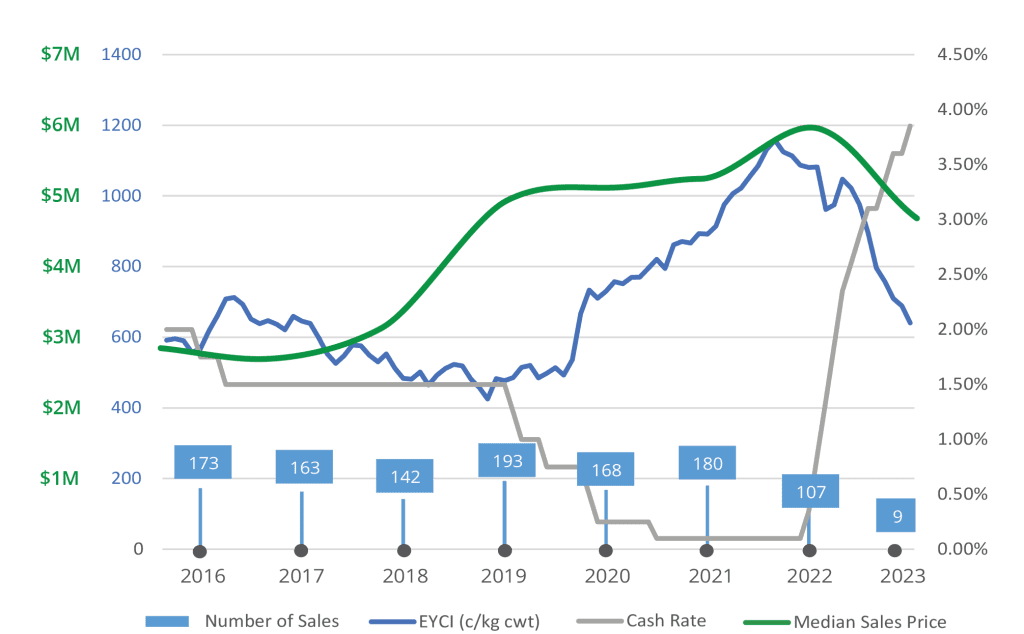A new report has found Queensland rural property sales in the first quarter of this year hit their lowest level since the Global Financial Crisis of 2007-2008.
Stephen Cameron is the national director of valuation and advisory services at Colliers Agribusiness and author of the agency’s latest Queensland Cattle Grazing Market Update.
He said despite the low number of transactions, the Queensland market has remained strong for the first quarter of 2023 for both cattle breeding and finishing country.
“In comparison to the peak in sales rates through the present cycle, activity for the first quarter in 2023 is down around 50 percent from this time last year.”
Mr Cameron said 2022 witnessed the fewest sales of grazing holdings larger than 5000 hectares in over 10 years, marking a decline of around 10pc compared to the least active period during the GFC.
“This was not unexpected given market transactions have been trading above the long-term average for several years. It has now reached a point where the bulk of vendors choosing to sell down or exit have now transacted.”
 Mr Cameron said other vendors are now taking the option to exit under the strong values to pay down debt and or consolidate.
Mr Cameron said other vendors are now taking the option to exit under the strong values to pay down debt and or consolidate.
“The demand for country remains relatively strong from the grass roots ‘mum and dads’ through to the corporate and institutional investors. Despite this, the due diligence process is now playing a greater role given the market is factoring a higher level of caution.”
Mr Cameron said the importance of repairs and maintenance expenses now carries more significance when making bidding decisions.
“During the demand peaks of 2020 and 2021, this aspect was somewhat overlooked due to the ‘fear of missing out’.”
Mr Cameron said since 2016, the Queensland rural property market has experienced a strong growth in values reflecting a compound annual rate of 11pc.
“The strength in the property market to date has been assisted by confidence in the cattle industry outlook and a strong appetite for expansion.”
“This was further fuelled by the low interest rate lending environment and firming commodity values from January 2020, which effectively saw cattle prices double within 18 months,” he said.
Mr Cameron said the Eastern Cattle Market Indicator (a seven-day rolling average of young cattle prices) provides a sound benchmarking commodity tool of the beef industry across the supply chain.
“Excluding the period in mid-2022 where there was a knee jerk reaction created by the risk of Foot and Mouth (FMD) and Lumpy Skin Disease (LSD) outbreaks, the EYCI has maintained a declining trend since October 2022.”
Mr Cameron said the price is currently trading at about 600 cents/kg which is down from 1100 cent/kg this time last year (or 43pc) – the lowest for more than two years.
“This, combined with the increased costs of funding with the Reserve Bank raising the cash rate 11 times since May 2022 to now 3.85pc has caused some potential purchasers to step back and reassess.”
Mr Cameron said the sheer lack of property listings will likely maintain the strength in property values moving forward.
“While good quality assets will be in demand, secondary quality properties are now slightly less marketable, unless at a competitive price point or strategically positioned, for example a near neighbour actively seeking further scale.”
“Other market influences include alternative on-farm income streams (through the sale of carbon credits under various approved methodologies) or negotiating with renewable companies under commercial terms for the development of solar or wind farms,” Mr Cameron explained.
Mr Cameron said this additional capital has allowed landholders to reinvest back into their assets or alternatively acquire additional country.
“Throughout the western Queensland market, ‘carbon aggregators’ have been considered to underpinned land values, given the acquisition of properties to establish carbon abatement projects to ultimately sell Australian Carbon Credits Units (ACCUs).”
Mr Cameron noted several properties were acquired from 2020 to early 2022, with some at the asking price, subject to due diligence for assessing the viability of the projects.
“This effectively gave the impression that land values were showing strong growth, with producers now having to compete with carbon traders, further driving firming value trends.”
Despite the market showing some increased level of prudence, Mr Cameron said the broader outlook remains relatively positive.
“Some agri economists are reporting that cattle prices will recover by 200pc by the third quarter of 2023, however this will be dependent on seasonal conditions and global demand for beef.”
“The property market is currently showing some mixed signals with some listings, considered to be within reasonable market parameters, marketed for an extended period without a result.”
On the other hand, Mr Cameron reports some properties have achieved prices well above market expectations at auction.
“Purchasers are at various stages of how they are determining what an asset may bring to the business and therefore its value.”
Until the Queensland rural property market finds its feet, Mr Cameron said distortions will continue until it is clear what direction the market will take.

